The cuckoo family Cuculidae contains six subfamilies. The first three listed below are found in the New world, while the remaining three are found in the Old World.
* Coccyzinae – New World Cuckoos
* Neomorphinae – New World Ground Cuckoos
* Crotophaginae – Anis
* Cuculinae – Old World Cuckoos
* Phaenicophaeinae – Malkohas and Couas
* Centropodinae – Coucals
This article is about the Cuculinae subfamily which contains brood parasitic Old World cuckoos. The are arborel cuckoos, spending much of ther time in trees looking for insects, especially caterpillars. There are 8 genera that contain more than one sprcies. These are discribed briefly below.
* Cacomantis: 9 species. They have mainly brown and grey plumage. Their tails are graduated and barred. Many have caterpillars on their list of favorite foods and they thus tend to be arboreal.
* Cercococcyx: 3 species. They all have "long-tailed" as part of their name. They are found in Africa. They are secretive and not often photographed. Their habitat are forests and thickets where they are mainly arborieal in trees but also in thckets.
* Chrysococcyx: 11 species. Many of the bronze-cuckoos have bronze-like coloring on some of their upperparts. For many of the species the males and females have different plumage. They are all parasitic, laying their eggs in the nests of other species. Most live arboreally in forests where they feed on caterpillars and other insects. They are found in Africa, Asia, and Australasia.
* Clamator: 4 species These are brood parasites, which lay a single egg in the nests of medium sized hosts, such as magpies, starlings, shrikes, laughingthrushes, bulbuls and babblers, depending on location. Clamator cuckoos are found in warmer parts of southern Europe and Asia, and in Africa south of the Sahara Desert. These are birds of warm open scrubby habitats. Some species are partially migratory, leaving for warmer and wetter areas in winter.These are large cuckoos, with broad chestnut wings and long narrow tails. They are strikingly patterned with black, white and brown plumage. The sexes are similar.
* Cuculus: 10 species. These are vocal species, with persistent and loud calls. They feed on large insects, especialy hairy caterpillars, which are distasteful to many birds. They prefer open woodland instead of thick forest. Most have grey upperparts, partially-barred pale underparts. Many have yellow feet and eye-rings.
* Eudynamys: 2 or 3 species. These koel cuckoos are found in Asia, Australia, and the Pacific. The males have mainly black plumage while females have dark brown upperparts with light freckles and heavily striped whitish underparts. The bills are pale grey-green, except for the black-billed koel, a subspecies of the Asian Koel. They are brood parasitic.
* Hierococcyx: 8 species. The hawk-cuckoos resemble hawks, not only in apperance but also some of their behavior such as how they fly and land on a perch They have yellow eye-rings and yellow feet.
* Surniculus 4 species. The drongo-cckoos have mainly black plumage. They resemble drongos which have the same general shape and also have black plumage. Whether or not there is an advantage to this resemblance is unknown. It could be a coincidence.
The cuckoo family Cuculidae
The cuckoo family Cuculidae is the only family of the order Cuculiformes. The family is represented on all continents except Antarctica. Most species reside in tropical or subtropical environments. Those in temperate locations migrate to avoid cool or cold winters. In addition to cuckoos, the family Cuculidae also includes the roadrunners, koels, malkohas, couas, coucals and anis. The coucals and anis are sometimes separated as distinct families. The cuckoos are generally medium sized slender birds. The majority are of the cuculidae family are arboreal, with a sizeable minority that is terrestrial.
Cuckoos are medium sized birds that range in size from 15-63 cm. There is generally little sexual dimorphism in size, but where it exists, it can be either the male or the female that is larger, depending on the genera. There are two basic body forms, arboreal species which are slender and terrestrial species which are more heavy set and have stronger legs. Almost all species have long tails which are used for steering in terrestrial species and as a rudder during flight in the arboreal species.
Many species are brood parasites, laying their eggs in the nests of other species, but the majority of species raise their own young. The brood parasitic birds usually only parasitize a single host species or a small group of closely related host species. They tend to remove a host egg when they lay one of their own in a nest. This both prevents the host species from realizing their nest has been parasitized and reduces food competition for the parasitic nestling once it hatches. Some brood parasites will eliminate all their nest-mates shortly after hatching. If the host removes a parasitic egg or chick, the adult parasitic birds may retaliate by destroying the nest.
There has been an evolutionary arms race between the cuckoos that leave their eggs in other nests, and the hosts that get these unwanted presents. The cuckoos have evolved to be able to lay their eggs faster than most other species and the eggs need less incubation time before hatching. These eggs often resemble the host eggs to prevent detection of an invader egg. The drongo-cuckoos resemble their host. Some hosts have evolve to be social so the colony can be on the lookout for an invader trying to deposit an egg. Others have more than one brood of chicks per year so there will be replacements for any losses due to cuckoos.
Cuckoos feed on insects, small animals, seeds, and fruit. For many cuckoo species, caterpillars are their favorite food; even hairy caterpillars that are avoided by most other birds. Cuckoos can consume hairy caterpillars because of their ability to shed their abdominal lining and get rid of the hairs via a pellet. Another favorite food of many cuckoos are grasshoppers. We may find it repugnant that some cuckooos are brood parasitic and they or their offspring even kill the host's chicks, but on the plus side cuckoos help prevent plagues of caterpillars and grasshoppers!
Almost all cuckoos are shy which can make them a challenge to observe and photograph. Consistent with this behavior, they are not colonial breeders. These traits may be have their roots in their brood parasitic behavior. Stealth is a good characteristic if you want to sneak an egg into a host's nest.
* Coccyzinae – New World Cuckoos
* Neomorphinae – New World Ground Cuckoos
* Crotophaginae – Anis
* Cuculinae – Old World Cuckoos
* Phaenicophaeinae – Malkohas and Couas
* Centropodinae – Coucals
This article is about the Cuculinae subfamily which contains brood parasitic Old World cuckoos. The are arborel cuckoos, spending much of ther time in trees looking for insects, especially caterpillars. There are 8 genera that contain more than one sprcies. These are discribed briefly below.
* Cacomantis: 9 species. They have mainly brown and grey plumage. Their tails are graduated and barred. Many have caterpillars on their list of favorite foods and they thus tend to be arboreal.
* Cercococcyx: 3 species. They all have "long-tailed" as part of their name. They are found in Africa. They are secretive and not often photographed. Their habitat are forests and thickets where they are mainly arborieal in trees but also in thckets.
* Chrysococcyx: 11 species. Many of the bronze-cuckoos have bronze-like coloring on some of their upperparts. For many of the species the males and females have different plumage. They are all parasitic, laying their eggs in the nests of other species. Most live arboreally in forests where they feed on caterpillars and other insects. They are found in Africa, Asia, and Australasia.
* Clamator: 4 species These are brood parasites, which lay a single egg in the nests of medium sized hosts, such as magpies, starlings, shrikes, laughingthrushes, bulbuls and babblers, depending on location. Clamator cuckoos are found in warmer parts of southern Europe and Asia, and in Africa south of the Sahara Desert. These are birds of warm open scrubby habitats. Some species are partially migratory, leaving for warmer and wetter areas in winter.These are large cuckoos, with broad chestnut wings and long narrow tails. They are strikingly patterned with black, white and brown plumage. The sexes are similar.
* Cuculus: 10 species. These are vocal species, with persistent and loud calls. They feed on large insects, especialy hairy caterpillars, which are distasteful to many birds. They prefer open woodland instead of thick forest. Most have grey upperparts, partially-barred pale underparts. Many have yellow feet and eye-rings.
* Eudynamys: 2 or 3 species. These koel cuckoos are found in Asia, Australia, and the Pacific. The males have mainly black plumage while females have dark brown upperparts with light freckles and heavily striped whitish underparts. The bills are pale grey-green, except for the black-billed koel, a subspecies of the Asian Koel. They are brood parasitic.
* Hierococcyx: 8 species. The hawk-cuckoos resemble hawks, not only in apperance but also some of their behavior such as how they fly and land on a perch They have yellow eye-rings and yellow feet.
* Surniculus 4 species. The drongo-cckoos have mainly black plumage. They resemble drongos which have the same general shape and also have black plumage. Whether or not there is an advantage to this resemblance is unknown. It could be a coincidence.
The cuckoo family Cuculidae
The cuckoo family Cuculidae is the only family of the order Cuculiformes. The family is represented on all continents except Antarctica. Most species reside in tropical or subtropical environments. Those in temperate locations migrate to avoid cool or cold winters. In addition to cuckoos, the family Cuculidae also includes the roadrunners, koels, malkohas, couas, coucals and anis. The coucals and anis are sometimes separated as distinct families. The cuckoos are generally medium sized slender birds. The majority are of the cuculidae family are arboreal, with a sizeable minority that is terrestrial.
Cuckoos are medium sized birds that range in size from 15-63 cm. There is generally little sexual dimorphism in size, but where it exists, it can be either the male or the female that is larger, depending on the genera. There are two basic body forms, arboreal species which are slender and terrestrial species which are more heavy set and have stronger legs. Almost all species have long tails which are used for steering in terrestrial species and as a rudder during flight in the arboreal species.
Many species are brood parasites, laying their eggs in the nests of other species, but the majority of species raise their own young. The brood parasitic birds usually only parasitize a single host species or a small group of closely related host species. They tend to remove a host egg when they lay one of their own in a nest. This both prevents the host species from realizing their nest has been parasitized and reduces food competition for the parasitic nestling once it hatches. Some brood parasites will eliminate all their nest-mates shortly after hatching. If the host removes a parasitic egg or chick, the adult parasitic birds may retaliate by destroying the nest.
There has been an evolutionary arms race between the cuckoos that leave their eggs in other nests, and the hosts that get these unwanted presents. The cuckoos have evolved to be able to lay their eggs faster than most other species and the eggs need less incubation time before hatching. These eggs often resemble the host eggs to prevent detection of an invader egg. The drongo-cuckoos resemble their host. Some hosts have evolve to be social so the colony can be on the lookout for an invader trying to deposit an egg. Others have more than one brood of chicks per year so there will be replacements for any losses due to cuckoos.
Cuckoos feed on insects, small animals, seeds, and fruit. For many cuckoo species, caterpillars are their favorite food; even hairy caterpillars that are avoided by most other birds. Cuckoos can consume hairy caterpillars because of their ability to shed their abdominal lining and get rid of the hairs via a pellet. Another favorite food of many cuckoos are grasshoppers. We may find it repugnant that some cuckooos are brood parasitic and they or their offspring even kill the host's chicks, but on the plus side cuckoos help prevent plagues of caterpillars and grasshoppers!
Almost all cuckoos are shy which can make them a challenge to observe and photograph. Consistent with this behavior, they are not colonial breeders. These traits may be have their roots in their brood parasitic behavior. Stealth is a good characteristic if you want to sneak an egg into a host's nest.
Cuckoo family members are zygodactyl: they have the 2 inner toes facing forward and 2 two outer toes facing to the rear.
Old World Cuckoos
Genus Cacomantis
The genus name is derived from the Greek kakos meaning evil or ill-boding and mantis for prophet and is derived from their association with "rains" being supposed to be predict ill fortune and bad weather. The cuckoos of this genus have mainly brown and grey plumage. Their tails are graduated and barred. Many have caterpillars on their list of favorite foods and they thus tend to be arboreal.
Cuckoo,_Banded Bay Cacomantis sonneratii
Description: The Banded Bay Cuckoo has brown and rufous upperparts. It has light underparts with dark brown barring. There is a whitish supercilium and dark eye-line.
Range: Southeast Asia, Indonesia, Malaysia, Phillippines.
Habitat: Forest, scrub, open land.
Diet: Insects, especially caterpillars.
Conservation status: Least concern.
Image by: 1) Sandeep Gangadharan 2) Vil.Sandi 3) LonelyShrimpRange: Southeast Asia, Indonesia, Malaysia, Phillippines.
Habitat: Forest, scrub, open land.
Diet: Insects, especially caterpillars.
Conservation status: Least concern.



Cuckoo,_Brush Cacomantis variolosus
Description: The brush cuckoo has grey-brown upperparts with a grey head. It has a buff breast. The under-tail is brown with white tips and bars.
Range: Australasia, Southeast Asia.
Habitat: Forest, scrub, plantations.
Diet: Insect, especially caterpillars. Also spiders, snails.
Conservation status: Least concern.
Image by: 1) Katerina_Tvardikova 2) Aviceda - Queensland 3) David Cook - Australia 4) Graham_Winterflood 5) Sergey_Yeliseev Range: Australasia, Southeast Asia.
Habitat: Forest, scrub, plantations.
Diet: Insect, especially caterpillars. Also spiders, snails.
Conservation status: Least concern.
2) Juvenile



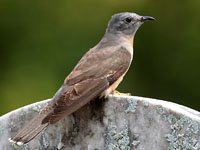

Cuckoo,_Chestnut-breasted Cacomantis castaneiventris
Description: The chestnut-breasted cuckoo has a chestnut breast and belly. The upperparts are dark grey-blue and the eyes have a yellow eye-ring. The under-tail is barred black-and-white. The chestnut-breasted cuckoo has much darker underparts than the similar brush cuckoo (C. variolosus) and thefan-tailed cuckoo (C. flabelliformis),
Range: Australia, New Guinea.
Habitat: Forest and scrub between 1000 - 2000 meters.
Diet: Insects, especially caterpliiars. Mostly arboreal, but will fly from tree for prey on ground.
Conservation status: Least concern.
Image by:
1, 2) Katerina_Tvardikova 3) Tom Tarrant - northern Australia 4) Markaharper - Papua New GuineaRange: Australia, New Guinea.
Habitat: Forest and scrub between 1000 - 2000 meters.
Diet: Insects, especially caterpliiars. Mostly arboreal, but will fly from tree for prey on ground.
Conservation status: Least concern.


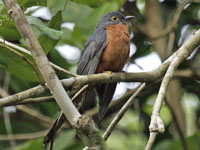
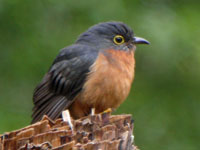
Cuckoo,_Fan-tailed Cacomantis flabelliformis
Description: The fan-tailed cuckoo has dark grey upperparts and yellow eye-rings. The underparts are buff. The under-tail is barred black-and-white. It has yellow eye-rings.
Range: Australasia.
Habitat: Forests from temperate to tropical. Also open areas such as orchards and gardens.
Diet: Insects, fruits, small reptiles and birds.
Conservation status: Least concern.
Image by: 1, 5, 6) David Cook 2) JJ Harrison - Tasmania, Australia 3) Aviceda - Dayboro, SE Queensland, AustraliaRange: Australasia.
Habitat: Forests from temperate to tropical. Also open areas such as orchards and gardens.
Diet: Insects, fruits, small reptiles and birds.
Conservation status: Least concern.
4) Yip Kee Yap at Jerrara Dam, NSW, Australia
1) Juvenile





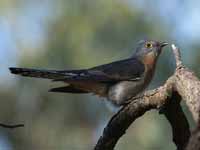
Cuckoo,_grey-bellied Cacomantis passerinus
Description: The grey-bellied cuckoo has mainly grey plumage with paler underparts. Some females are are of the hepatic form which has dark-barred reddish brown upperparts, an unbarred tail, and strongly dark-barred whitish underparts.
Range: Indian subcontinent, Myanmar.
Habitat: Lightly timbered land and cultivated areas.
Diet: Insects including caperpillars.
Conservation status: Least concern.
Image by: 1) Karunakar_Rayker 2) Thimindu Goonatillake - India 3, 4) Nagesh Kamath - southern India Range: Indian subcontinent, Myanmar.
Habitat: Lightly timbered land and cultivated areas.
Diet: Insects including caperpillars.
Conservation status: Least concern.


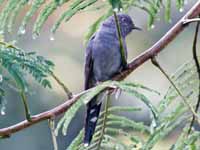
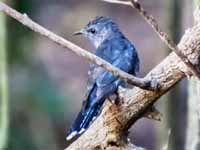
Cuckoo,_Moluccan Cacomantis heinrichi
Description: The Moluccan cuckoo has grey upperparts with brown wings and back tail. The bill is black and the eyes have a yellow eye-ring. It has rufous underparts with a dark throat.
Range: Maluku Islands of Indonesia.
Habitat: Subropica and tropical forests.
Conservation status: Least concern.
Image by: 1) Paulo Alves 2, 3) Pete MorrisRange: Maluku Islands of Indonesia.
Habitat: Subropica and tropical forests.
Conservation status: Least concern.
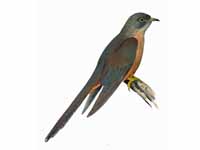
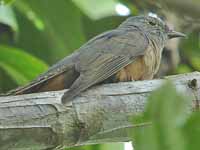

Cuckoo,_Pallid Cacomantis pallidus
Description: The pallid cuckoo has.grey upperparts. The head, nape, and underparts are pale grey. It has yellow eye-rings.
Range: Australasia
Habitat: Open forests and scrub landInsects.
Diet: Insects, especially caterpillars and grasshoppers.
Conservation status: Least concern.
Image by: 1) Oystercatcher 2) David Cook 3) Greg_Miles 4) Aviceda Range: Australasia
Habitat: Open forests and scrub landInsects.
Diet: Insects, especially caterpillars and grasshoppers.
Conservation status: Least concern.




Cuckoo,_Plaintive Cacomantis merulinus
Description: The male Plantive Cuckoo has.grey-brown upperparts.The head, throat, and upper-breast are grey while the rest of the underparts are orange. The female is often similar to the male but may also have reddish-brown upperparts with barring. In this case the underparts are paler with fainter barring. It is a brood parasite, laying its eggs in the nests of cisticolas, prinias and tailorbirds. The eggs are similar to those of the host species but are larger. Small birds often mob the cuckoo to drive it away from their nests.
Range: Southeast Asia, Indonesia, Malaysia, Philippines.
Habitat: Forest, scrubs, plantations, town.
Diet: Insects, especially caterpillars. Also fruit.
Conservation status: Least concern.
Image by: 1) JM Garg - India 2) Ron Knight - Thailand 3) Charles Lam - Hong Kong 4) Arie Frahman - IndonesiaRange: Southeast Asia, Indonesia, Malaysia, Philippines.
Habitat: Forest, scrubs, plantations, town.
Diet: Insects, especially caterpillars. Also fruit.
Conservation status: Least concern.
1) Juvenile 2) Female 3, 4) Male

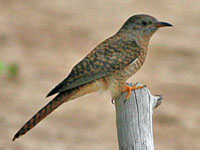
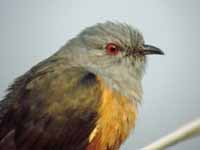

Koel,_White-crowned Cacomantis leucolophus
Description: The white-crowned koel, also known as the white-crowned cuckoo, has mainly black plumage and the bill is also black. There is a white stripe down the crown. The under-tail has white barring. and the bill is black. It was formerly placed as the sole member of Caliechthrus.
Range: New Guinea.
Habitat: Forest canopy.
Diet: Insects including caterpillars, fruits.
Conservation status: Least concern.
Range: New Guinea.
Habitat: Forest canopy.
Diet: Insects including caterpillars, fruits.
Conservation status: Least concern.
Image by: 1) Katerina_Tvardikova 2) Nik_Borrow
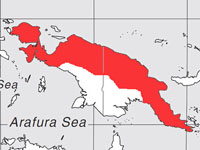

Genus Cercococcyx
The long-tailed cuckoos are found in Africa. They are secretive and not often photographed; mainly arborieal in trees but also in thckets.
Cuckoo, Barred Long-tailed Cercococcyx montanus
Description: The barred long-tailed cuckoo has a long tail which is white with heavy black barring. The upperparts are greenish-brown. The underparts are white with thin black bars. The eyes have a yellow eye-ring.
Range: East Africa and east-central Africa.
Habitat: Forests and also coastal thickets.
Diet: Insects, especially caterpillars; also snails.
Conservation status: Least concern.
No public domain images available.
Cuckoo, Dusky Long-tailed Cercococcyx mechowi
Description: The dusky long-tailed cuckoo has dark brown upperparts, head, and nape with a blue iridescence. The dark brown wings have buff and white spot. It has white underparts with dark brown bars. The eyes are dark brown, the beak is greenish-black, and the feet are yellow.
Range: Africa
Habitat: Forests with dense undrgrowth.
Diet: Insects including caterpillars; also spiders, snails, seeds.
Conservation status: Least concern.
No public domain images available.
Cuckoo, Olive Long-tailed Cercococcyx olivinus
Description: The olive long-tailed cuckoo has olive-brown upperparts. The long tail has white underparts with black barring. The eyes have a yellow eye-ring.
Range: Central Africa.
Habitat: Tropical rainforest.
Diet: Insects, especially caterpillars.
Conservation status: Least concern.
No public domain images available.
Genus Chrysococcyx
Many of the bronze-cuckoos have bronze-like coloring on some of their upperparts. For many of the species the males and females have different plumage. They are all parasitic, laying their eggs in the nests of other species. Most live arboreally in forests where they feed on caterpillars and other insects. They are found in Africa, Asia, and Australasia.
Cuckoo,_African_Emerald Chrysococcyx cupreus
Description: The male African emerald cuckoo has green upperparts and also upper-breast. The rest of the underparts are yellow. The female has green and brown upperparts and also upper-breast. The rest of her underparts are barred green-and-white.
Range: Africa.
Habitat: Forests, shade trees in towns.
Diet: Insects, especially caterpillars; also fruit. It forages in the mid and upper-stories of the forest.
Conservation status: Least concern.
Image by:
1) Maans_Booysen 2) Jim_Scarff 3) Ian White Range: Africa.
Habitat: Forests, shade trees in towns.
Diet: Insects, especially caterpillars; also fruit. It forages in the mid and upper-stories of the forest.
Conservation status: Least concern.
1) Female 2, 3) Male



Cuckoo,_Asian Emerald Chrysococcyx maculatus
Description: The male Asian emerald cuckoo has iridescent dark green upperparts, head, and upper-breast. The rest of the breast is white with green barring. Its bill is yellow with a black tip. The female has coppery-green upperparts with a rusty brown crown and nape. The underparts are white with green barring.
Range: Asia.
Habitat: Forest and forest edges.
Diet: Insects, including caterpillars.
Conservation status: Least concern.
Image by: 1) JJ Harrison - Thailand 2, 3) Somchai Kanchanasut - Rama IX Park, Bangkok, ThailandRange: Asia.
Habitat: Forest and forest edges.
Diet: Insects, including caterpillars.
Conservation status: Least concern.
1, 2) Female 3) Male

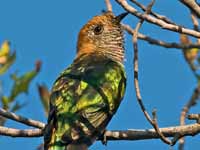

Cuckoo,_Black-eared Chrysococcyx osculans
Description: The black-eared cuckoo has grey upperparts. It has dark ear coverts and a white supercilium. It has a grey tail with a white tip.The throat is whitish and the underparts are pinkish-buff merging to white at the lower-belly and rump.
Range: Australasia, eastern Indonesia.
Habitat: Dry open forests and scrubs.
Diet: Insects, mainly caterpillars; also seeds. ƒ√
Conservation status: Least concern.
Image by: 1) Nik_Borrow 2) Aviceda - Bowra, SW Queensland, Australia 3, 4) David Cook Range: Australasia, eastern Indonesia.
Habitat: Dry open forests and scrubs.
Diet: Insects, mainly caterpillars; also seeds. ƒ√
Conservation status: Least concern.
4) Speckled Warbler feeding Black-eared Cuckoo chick.

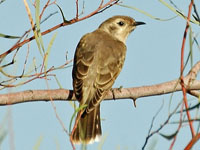


Cuckoo,_Dideric Chrysococcyx caprius
Description: The dideric cuckoo, also known as the diederick cuckoo, has green upperparts with copper-sheened areas on the back. It has whitish underparts with barred flanks. There is a broken white eye-line and green malar stripe. It is named after the call it makes.
Range: Sub-Saharan Africa and the southern Arabian Peninsula.
Habitat: Open woodlands, bushes, savanna.
Diet: Insects, especially caterpillars.
Conservation status: Least concern.
Image by: 1) Ian White - Garborone 2) Peter Steward - Kenya 3) Frik Erasmus 4) Derek_KeatsRange: Sub-Saharan Africa and the southern Arabian Peninsula.
Habitat: Open woodlands, bushes, savanna.
Diet: Insects, especially caterpillars.
Conservation status: Least concern.
1) Juvenile 4) Male offering female food while courting.
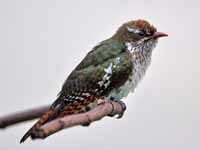

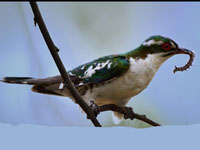

Cuckoo,_Horsfield's_Bronze- Chrysococcyx basalis
Description: The Horsfield's bronze-cuckoo has a bronze sheen on a brown back. The head has a brown cap, pale supercilium and dark brown eye-stripe. There are brown bars on whitish underparts. These bars fade away at the center of the underparts. The black-and-white undertail has a rufous center. The dark eye-line of this species differentiates it from the similar little bronze-cuckoo.
Range: Breeds in Australia, winters in Java.
Habitat: Relatively dry open forest and scrub land.
Diet: Insects, especially caterpillars.
Conservation status: Least concern.
Image by: 1) Aviceda - Australia 2) David Cook - Australia 3) Francesco_Veronesi 4) I Am birdsaspoetry.comRange: Breeds in Australia, winters in Java.
Habitat: Relatively dry open forest and scrub land.
Diet: Insects, especially caterpillars.
Conservation status: Least concern.

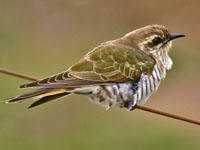


Cuckoo,_Klass's Chrysococcyx klaas
Description: The male Klaas’s cuckoo has glossy green upperparts and white underparts, plus a white patch behind the ear. the female has bronze-brown upperparts and greenish wing coverts. She has faintly barred pale underparts.
Range: Subsaharan Africa.
Habitat: Open forests, gardens.
Conservation status: Least concern.
Image by: 1) Nik_Borrow 2) Lip Kee Yap -
South Africa 3) Frans_Vandewalle - South Africa 4) Derek_Keats - South Africa 5) Carol Foil - Kenya Range: Subsaharan Africa.
Habitat: Open forests, gardens.
Conservation status: Least concern.
1) Juvenile 2, 3) Female 4, 5) Male
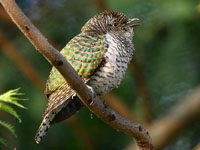



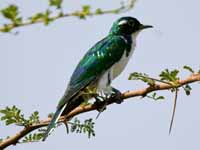
Cuckoo,_Little_Bronze- Chrysococcyx minutillus
Description: The little bronze-cuckoo has bronze upperparts. The underparts are white with bronze dashed lines. The male has red eyes with a red eye-ring while females have brown eyes with a light colored eye-ring. There is a white supercilium. It is similar to Horsfield's bronze cuckoo which has a dark eye-line while the little bronze-cuckoo does not.
Range: Southeast Asia and Australasia.
Habitat: Forest, thickets, gardens.
Diet: Insects, especially caterpillars.
Conservation status: Least concern.
Image by: 1) Tom Tarrant 2) Kazredracer - Northern Territory
3) David Cook - Australia 4) Brian_McCauley Range: Southeast Asia and Australasia.
Habitat: Forest, thickets, gardens.
Diet: Insects, especially caterpillars.
Conservation status: Least concern.




Cuckoo,_Long-billed Chrysococcyx megarhynchus
Description: The male long-billed cuckoo has dark brown upperparts with a black head and red eye-ring. Its underparts are.greyish-brown. The female has dark cinnamon upperparts with a dark grey-brown head. She has a cinnamon lower-breast and a rufous-buff belly with fine barring.
Range: New Guinea.
Habitat: Subtropical or tropical moist lowland forests.
Diet: Insects, mainly ccaterpillars.
Conservation status: Least concern.
Image by:
1) Katerina_Tvardikova 2) Francesco_VeronesiRange: New Guinea.
Habitat: Subtropical or tropical moist lowland forests.
Diet: Insects, mainly ccaterpillars.
Conservation status: Least concern.


Cuckoo,_Rufous-throated Bronze- Chrysococcyx ruficollis
Description: The rufous-throated bronze-cuckoo has green upperparts with bronze-like coloring on some of these upperparts. The nape is green while the forehaed and face are rufous. The underparts are barred white and green.
Range: New Guinea .
Habitat: Forests.
Diet: Insects, especially caterpillars.
Conservation status: Least concern.
Image by:
1) Katerina_Tvardikova 2) Francesco_Veronesi 3) Nik_BorrowRange: New Guinea .
Habitat: Forests.
Diet: Insects, especially caterpillars.
Conservation status: Least concern.

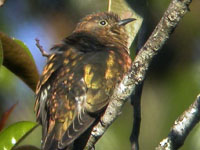

Cuckoo,_Shining-Bronze- Chrysococcyx lucidus
Description: The shining bronze-cuckoos, also known as the shining cuckoo, is the world's smallest cuckoo. It has bronze-green upperparts with white cheeks. The underparts are white with complete bronze bars. It has a black bill.
Range: Australasia.
Habitat: Forest, scrubs, gardens. In the breeding season it prefers wet areas.
Diet: Insects, especially caterpillars.
Conservation status: Least concern.
Image by: 1, 4) Laurie_Boyle 2) Tom Tarrant - Australia 3)DigitalTrails - New ZealandRange: Australasia.
Habitat: Forest, scrubs, gardens. In the breeding season it prefers wet areas.
Diet: Insects, especially caterpillars.
Conservation status: Least concern.


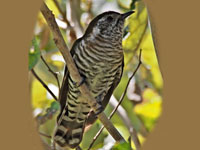

Cuckoo,_Violet Chrysococcyx xanthorhynchus
Description:The male violet cuckoo has glossy violet upperparts, head, chin, and breast. The belly is violet with white bars. There is a red eye-ring. The female has mottled greenish-bronze upperparts with a dark brown crown. The belly is grenish-bronze with white bars.
Range: Southeast Asia, Indonesia, Malaysia, Philppines.
Habitat: Subtropical and tropical moist forests. Also gardens, orchards, and rubber plantations.
Diet: Insects including caterpillars.
Conservation status: Least concern.
Image by: 1) Gee 2) KesavamurthyN 3) Rejaul_karim 4) Francesco VeronesiRange: Southeast Asia, Indonesia, Malaysia, Philppines.
Habitat: Subtropical and tropical moist forests. Also gardens, orchards, and rubber plantations.
Diet: Insects including caterpillars.
Conservation status: Least concern.
1) Female 2 - 4) Male

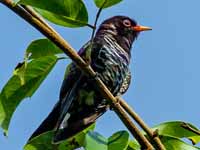


Cuckoo,_White-eared_Bronze- Chrysococcyx meyerii
Description: The white-eared bronze-cuckoo has crescent-shaped white ear-coverts. It has glossy green upperparts and a green crown. The female has a chestnut fore-crown. The underparts are white with glossy green barring.
Range: New Guinea
Habitat: Forest and gardens.
Diet: Insects including caterpillars.
Conservation status: Least concern.
Image by:
1) Katerina_Tvardikova 2, 3) Nik_BorrowRange: New Guinea
Habitat: Forest and gardens.
Diet: Insects including caterpillars.
Conservation status: Least concern.


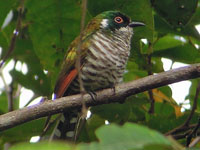
Cuckoo,_Yellow-throated Chrysococcyx flavigularis
Description: The male yellow-throated cuckoo has bronze-brown upperparts. The throat, upper-breast, and eye-rings are yellow. The rest of the underparts are yellowish-green with brown barring. Females do not have yellow on the throat.
Range: African tropical rainforest.
Habitat: Old forests, high in canopy.
Diet: Insects, especially caterpillars; fruit.
Conservation status: Least concern.
Image by:
1 )Michael and Helen Cox 2) Nik_Borrow- GhanaRange: African tropical rainforest.
Habitat: Old forests, high in canopy.
Diet: Insects, especially caterpillars; fruit.
Conservation status: Least concern.
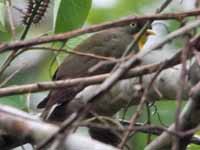

Genus Clamator
All Clamator cuckoos are brood parasites, which lay a single egg in the nests of medium sized hosts, such as magpies, starlings, shrikes, laughingthrushes, bulbuls and babblers, depending on location. Clamator cuckoos are found in warmer parts of southern Europe and Asia, and in Africa south of the Sahara Desert. These are birds of warm open scrubby habitats. Some species are partially migratory, leaving for warmer and wetter areas in winter.These are large cuckoos, with broad chestnut wings and long narrow tails. They are strikingly patterned with black, white and brown plumage. The sexes are similar.
Cuckoo,_Chestnut-winged Clamator coromandus
Description: The chestnut-winged cuckoo has chestnut wings. It has dark glossy upperparts and tail.The head is black with a long crest. There is a white half collar. The throat and upper-breast are rufous, but the rest of the ubderparts are white.
Range: Southeast Asia, Indonesia, Malaysia, Philippines.
Habitat: Bushes and small trees, often in wet areas.
Diet: Insects, especialy caterpillars. Also spiders, fruit.
Conservation status: Least concern.
Image by: 1) Vijay Ismavel 2) Sandeep Gangadharan 3) David_Cook - Bhutan Range: Southeast Asia, Indonesia, Malaysia, Philippines.
Habitat: Bushes and small trees, often in wet areas.
Diet: Insects, especialy caterpillars. Also spiders, fruit.
Conservation status: Least concern.
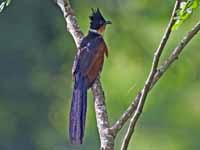


Cuckoo,_Great-spotted Clamator glandarius
Description: The great-spotted cuckoo has dark grey upperparts with white spots and a dark grey cap with a pale grey crest. The face, throat, and upper-breast are buffy. The rest of the underbarts are white.
The chick emits a repellant that helps protect it and the host chicks from predators; one of the few times brood parasitic behavior has any benefit for the host.
Range: Southwest Europe, western Asia, Africa.
Habitat: Scrub and open woodland.
Conservation status: Least concern.
Image by: 1) Eran Finkle 2) Johann du Preez 3 Frank_Vassen - Portugal 4) Francesco Veronesi - Spain The chick emits a repellant that helps protect it and the host chicks from predators; one of the few times brood parasitic behavior has any benefit for the host.
Range: Southwest Europe, western Asia, Africa.
Habitat: Scrub and open woodland.
Conservation status: Least concern.
1, 2) Juvenile
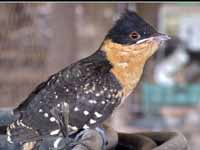



Cuckoo,_ Pied Clamator jacobinus
Description: The pied cuckoo, also known as the Jacobian cuckoo, has black upperparts with a black cap and crest. The underpart are white and there is a white patch on the wings.
Range: Africa, Asia.
Habitat: Scrub, open woodland, plains.
Diet: Insects including caterpillars,grasshoppers. Also snails, fruit.
Conservation status: Least concern.
Image by:
1) Shantanu Kuveskar 2) Kosky Koshy 3) Derek_Keats 4) Koshy KoshyRange: Africa, Asia.
Habitat: Scrub, open woodland, plains.
Diet: Insects including caterpillars,grasshoppers. Also snails, fruit.
Conservation status: Least concern.

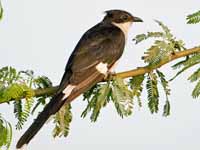
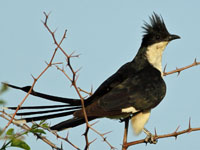

Cuckoo,_Levaillant's Clamator levaillantii
Description:The Levaillant's cuckoo has black upperparts, head, and crest. There is a white wing patch and the upper-tail is white tipped. The under-tail has rows of white tips visible because the tail is graduated. The underparts are pale with heavy black streaks on the breast.
Range: Africa.
Habitat: Forest, open woodlands, scrub.
Diet: Insects, including caterpillars and grasshoppers.
Conservation status: Least concern.
Image by: 1, 2) Derek Keats - South Africa 3) Peter_Steward 4) Ian White - Botswana Range: Africa.
Habitat: Forest, open woodlands, scrub.
Diet: Insects, including caterpillars and grasshoppers.
Conservation status: Least concern.

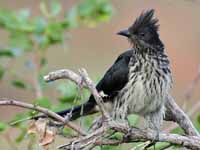


Genus Cuculus
These Old World cuckoos lay a single egg in the host's nest. The cuckoo chick hatches earlier and grows faster than the host's chicks. It usually evicts the host's eggs or chicks from the nest. These are vocal species, with persistent and loud calls. They feed on large insects, especialy hairy caterpillars, which are distasteful to many birds. They prefer open woodland instead of thick forest. Most have grey upperparts, partially-barred pale underparts. Many have yellow feet and eye-rings.
Cuckoo,_African Cuculus gularis
Description: The African cuckoo has grey upperparts, head, and wings. The throat and breast are pale grey. The belly is whitish with dark grey bars. The upper-tail is white tipped while the under-tail has rows of white tips visible because the tail is graduated. The African cuckoo has yellow legs, feet, eye-ring. The bill is also yellow, but with a black tip.
Range: Africa, south of the Sahara.
Habitat: Their typical habitat is savannah with scattered acacia trees and open woodland. They are not present in dense forest or in arid regions. Some of the species migrate with the rainy season, probablyseeking more insects.
Diet: Insects, especially caterpillars. Also beetles, termites.
Conservation status: Least concern.
Image by:
1) Bernard Dupont - South Africa 2) Ian White - Zimbabwe 3) Nik Borrow - Kenya 4) Alan_Manson - South AfricaRange: Africa, south of the Sahara.
Habitat: Their typical habitat is savannah with scattered acacia trees and open woodland. They are not present in dense forest or in arid regions. Some of the species migrate with the rainy season, probablyseeking more insects.
Diet: Insects, especially caterpillars. Also beetles, termites.
Conservation status: Least concern.
1) Juvenile

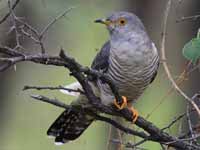


|
Cuckoo,_Black Cuculus clamosus
Description: The black cuckoo plumage varies by subspecies. C. c. clamosus is almost entirely black, sometimes with white tips on tail feathers. C. c. gabonensis has black upperparts, a red throat and upper-breast, the lower-breast and belly is barred black and white.
Range: C. c. gabonensis is resident in central Africa. C. c. clamosus breeds in southern Africa and migrates north.
Habitat: Woodlands, but not thick forest.
Diet: Insects, especially caterpillars and grasshoppers.
Conservation status: Least concern.
Image by: 1) Nik_Borrow - Cameroon 2) Ian White - South Africa 3) Sergei Golyshev - Tanzania 4)) Donald MacauleyRange: C. c. gabonensis is resident in central Africa. C. c. clamosus breeds in southern Africa and migrates north.
Habitat: Woodlands, but not thick forest.
Diet: Insects, especially caterpillars and grasshoppers.
Conservation status: Least concern.
1) C. c. gabonensis



Cuckoo,_Common Cuculus canorus :
Description: The common cuckoo has grey upperparts and pale underparts with dark bars on the lower-breast and belly. Most females have the same plumage as males, but a rufous morph has reddish-brown upperparts with dark bars.
Range: Europe, Asia, Africa.
Habitat: Open woodlands, scrub, meadows.
Diet: Insects, especially caterpillars. Also beetles,grasshoppers, snails.
Conservation status: Least concern.
Image by: 1) Imrun_Shah - Pakistan 2) Steve Garvie - Scotland 3, 4) Vogelartinfo Range: Europe, Asia, Africa.
Habitat: Open woodlands, scrub, meadows.
Diet: Insects, especially caterpillars. Also beetles,grasshoppers, snails.
Conservation status: Least concern.
1) Rufous morph female
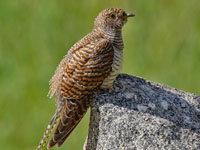

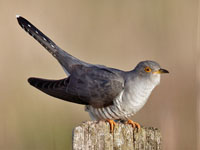

Cuckoo,_Himalayan Cuculus saturatus
Description: The male Himalayan cuckoo has grey upperparts, head, and upper-breast. It has a yellow eye-ring. The creamy-white belly has dark bars. Female are similar with slight rufous to the upper-breast. The female also has a rufous morph with reddish-brown barred upperparts. The Himalayan cuckoo is slightly smaller than the similar Oriental cuckoo which also has slightly shorter wings.
Range: Asia, Indonesia, Malaysia, Philippines .
Habitat: A variety of wooded areas and also meadows.
Diet: Insects, especially caterpillars. Also spiders, eggs, ckicks.
Conservation status: Least concern.
Image by: 1) Tom Tarrant - Australia 2) Tony_Castro - Thailand 3) Hiyashi_HakaRange: Asia, Indonesia, Malaysia, Philippines .
Habitat: A variety of wooded areas and also meadows.
Diet: Insects, especially caterpillars. Also spiders, eggs, ckicks.
Conservation status: Least concern.
1) Rufous morph


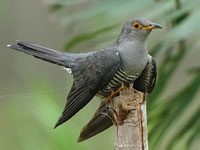
Cuckoo,_Indian Cuculus micropterus
Description: The Indian cuckoo has grey upperparts. The underparts are pale with black barring. There is a yellow to grey eye-ring and a barred tail with a white tip. The Indian cuckoo is a brood parasite. It lays its single egg mostly in the nests of drongos and crows. It removes and eats an egg from the host nest before laying its own. During the third or fourth day, the young bird bends its back when touched and heaves out other eggs or nestlings.
Range: Asia, Indonesia, Malaysia, Philippines.
Habitat: Forests, scrub, gardens.
Diet: Insects, especially caterpillars. Also grasshoppers, fruit.
Conservation status: Least concern.
Image by: 1, 2, 3, 4) Vijay Ismavel - IndiaRange: Asia, Indonesia, Malaysia, Philippines.
Habitat: Forests, scrub, gardens.
Diet: Insects, especially caterpillars. Also grasshoppers, fruit.
Conservation status: Least concern.
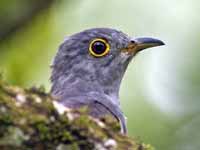


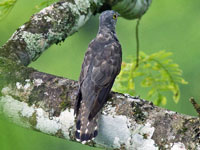
Cuckoo,_Lesser Cuculus poliocephalus
Description: The lesser cuckoo has grey upperparts, head, neck, and upper-breast. The lower-breast and belly are white with black bars The wing coverts and upper-tail are blackish. There is a yellow eye-ring and yellow feet. The female sometimes occurs in a rufous morph.
Range: Breeds in Asia and winters in Sri Lanka plus eastern Africa.
Habitat: Forests and scrub.
Diet: Insects, especially caterpillars. Also beetles, ants.
Conservation status: Least concern.
Image by:
1) Ron Knight 2) Pseudolapiz 3) Dave_CurtisRange: Breeds in Asia and winters in Sri Lanka plus eastern Africa.
Habitat: Forests and scrub.
Diet: Insects, especially caterpillars. Also beetles, ants.
Conservation status: Least concern.
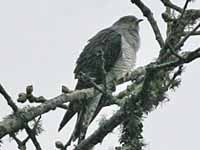


Cuckoo,_Madagascar Cuculus rochii
Description: The Madagscar cuckoo has grey upperparts The head, throat, and upper-breast are lighter grey. The lower-breast and belly are white with black barring. The wing coverts and upper-tail are blackish. There is a yellow eye-ring and yellow feet. The female does not occur in a rufous morph. The voice of the male helps differentiate the Madagascar cuckoo from other Curulus cuckoos. According to "Cuckoos of thw World" by Reeitezze et. al., the voice is "ho-ho-ho-hu" or "cuck-cuck-ooo".
Range: Breeds in Madagascar, winters in Africa.
Habitat: Forest and scrubs. Also marsh.
Diet: Insects, especially caterpillars.
Conservation status: Least concern.
Image by: 1) Heinonlein 2) Amy_McAndrews 3) Alan_HarperRange: Breeds in Madagascar, winters in Africa.
Habitat: Forest and scrubs. Also marsh.
Diet: Insects, especially caterpillars.
Conservation status: Least concern.



Cuckoo,_Oriental Cuculus optatus :
Description: The male Oriental Cuckoo has grey upperparts, head, and upper-breast. It has a yelloweye-ring. The creamy-white belly has dark bars. Female similar with slight rufous to upper breast. The female also has a rufous morph with reddish-brown barred upperparts. The Himalayan cuckoo is slightly smaller than the very similar Oriental cuckoo which also has slightly shorter wings. The common cuckoo is also similar to the Oriental cuckoo. It is slightly paler grey and the barring on the underparts is a little narrower.
Range: Asia (including Japan), Indonesia, Malaysia, Philippines, Australia.
Habitat: A variety of wooded areas.
Diet: Insects, especially caterpillars.
Conservation status: Least concern.
Image by: 1) Judith Lukin-Amundsen - Australia 2) M_Nishimura - Japan 3) Tom Tarrant - Australia Range: Asia (including Japan), Indonesia, Malaysia, Philippines, Australia.
Habitat: A variety of wooded areas.
Diet: Insects, especially caterpillars.
Conservation status: Least concern.



Cuckoo,_Red-chested Cuculus solitarius
Description: The red-chested cuckoo has dark grey upperparts and a tail tipped with white. The under-tail is dark grey with rows of white tips indicating that the tail is graduated. The throat and sides of the head are pale grey. The upper-breast is pale red with variable amounts of barring. THe lower-breast is whitish with black bars while the belly is whitish wih no bars. Juveniles have black uuperparts, head, neck.
Range: Africa (south of Sahara).
Habitat: Prefers woodlands.
Diet: Insects, especially caterpillars.Also spiders, snails, centipedes, berries.
Conservation status: Least concern.
Image by: 1) Arno Meintjes 2, 4) Nik_Borrow - Uganda 3) Brendan_Ryan Range: Africa (south of Sahara).
Habitat: Prefers woodlands.
Diet: Insects, especially caterpillars.Also spiders, snails, centipedes, berries.
Conservation status: Least concern.
1, 2) Juvenile




Cuckoo,_Sunda Cuculus lepidus
Description: The Sundra cuckoo has dark grey upperparts and head. The throat and upper-breast are paler grey and the rest of underparts are buff with black bars. It has yellow eye-ring and feet. The female also appears in a morph with rufous barred upperparts.
Range: Indonesia, Malaysia, Thailand.
Habitat: Forests.
Diet: Insects, especially caterpillars. Also fruit.
Conservation status: Least concern.
Image by: 1) Tony Castro - BorneoRange: Indonesia, Malaysia, Thailand.
Habitat: Forests.
Diet: Insects, especially caterpillars. Also fruit.
Conservation status: Least concern.

Genus Eudynamys
These koel cuckoos are found in Asia, Australia, and the Pacific. The males have mainly black plumage while females have dark brown upperparts with light freckles and heavily striped whitish underparts. The bills are pale grey-green, except for the black-billed koel, a subspecies of the Asian Koel. They are brood parasitic.
Koel,_Asian Eudynamys scolopaceus
Description: The Asian koel, also known as the common koel, is a large cuckoo. The male has a glossy blue-black body and dark blue tail. The bill is pale greenish-grey, eyes are red, the legs are grey. The female has dark brown upperparts with light freckles and heavily striped whitish underparts. It is similar to the Austrlian koel, but their ranges do not overlap. It is brood parastic.
The black-billed koel, Eudynamys s. melanorhynchus, is sometimes considered to be a separate species. It is found on Indonesian islands of Sulawesi, Sula, Banggai, Togian.
Range: South and Southeast Asia, China.
Habitat: Woodlands and gardens.
Diet: Insects including caterpillars, small vertibrates, eggs, fruit.
Conservation status: Least concern.
Image by: 1) Steve_Garvie - Sri Lanka 2) Doug_Janson 3) Ravi Vaidyanathan 4) Lip_keeThe black-billed koel, Eudynamys s. melanorhynchus, is sometimes considered to be a separate species. It is found on Indonesian islands of Sulawesi, Sula, Banggai, Togian.
Range: South and Southeast Asia, China.
Habitat: Woodlands and gardens.
Diet: Insects including caterpillars, small vertibrates, eggs, fruit.
Conservation status: Least concern.
1, 2) Female 3, 4, 5) Male




Koel, Australian Eudynamys orientalis
Description: The Australian koel, also known as the Pacific Koel, is a large cuckoo. The male has a glossy blue-black body and dark blue tail. The bill is pale greenish-grey, eyes are red, the legs are grey. The female has dark brown upperparts with light freckles, light moustacial line, and heavily striped whitish underparts. Their hosts are mainly large honeyeaters (especially noisy friarbirds and red wattlebirds). The Australian koel is similar to the Asian koel, but their ranges do not overlap.
Range: Australasia.
Habitat: Forest, woodlands, gardens.
Conservation status: Least concern.
Image by: 1) Vinni 2) Aviceda 3) Geoff_WhalanRange: Australasia.
Habitat: Forest, woodlands, gardens.
Conservation status: Least concern.
1) Female 2, 3) Male

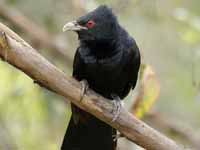

Genus Hierococcyx
The hawk-cuckoos resemble hawks, not only in apperance but also some of their behavior such as how they fly and land on a perch They have yellow eye-rings and yellow feet.
Cuckoo,_Common_Hawk- Hierococcyx varius
Description: The common hawk-cuckoo has dark grey upperparts. It has whitish underparts with pale rufous bars that meander. The throat is unstreaked. The yellow eyes have a yellow eye-ring. The feet are also yellow. It resembles a shikra in appearance its wing-beats and landing behavior. It is brood parasitic, using babblers as hosts.
Range: Indian subcontinent.
Habitat: Woodlands and gardens.
Diet: Insects including caterpillars.
Conservation status: Least concern.
Image by:
1) dhruvaraj 2) nbu2012 3) Raju_KasambeRange: Indian subcontinent.
Habitat: Woodlands and gardens.
Diet: Insects including caterpillars.
Conservation status: Least concern.

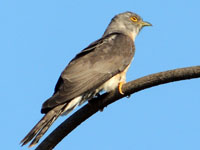
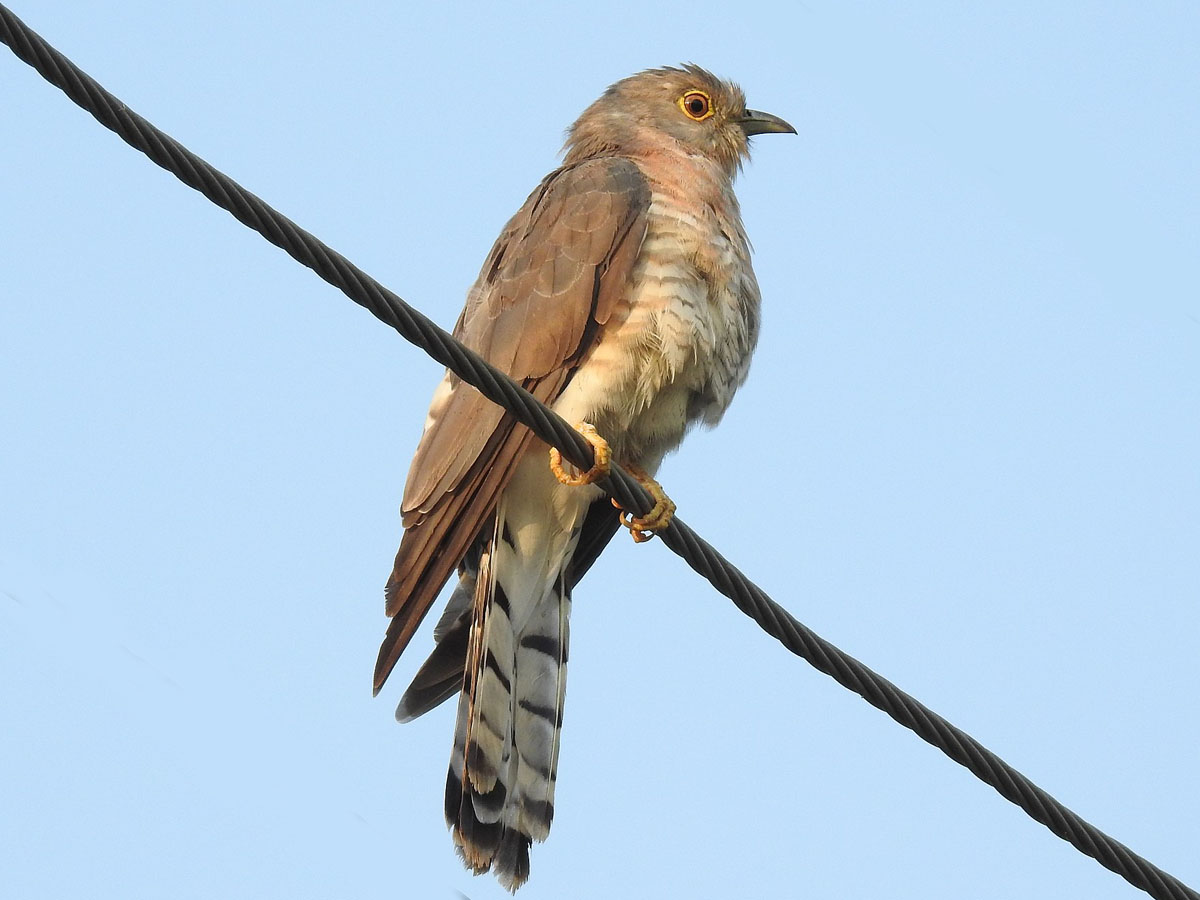
Cuckoo,_Dark_Hawk- Hierococcyx bocki
Description: The dark hawk-cuckoo has blackish upperparts and head with a grey throat. The breast is a rufous and white mix while the belly is barred black and white. There is a yellow eye-ring and the feet are also yellow. It was formerly considered conspecific with the large hawk-cuckoo.
Range: Indonesia, Malaysia .
Habitat: Forests.
Diet: Insects including caterpillars. Also eggs, fruit.
Conservation status: Least concern.
Image by: 1) Mike Prince - Borneo Range: Indonesia, Malaysia .
Habitat: Forests.
Diet: Insects including caterpillars. Also eggs, fruit.
Conservation status: Least concern.
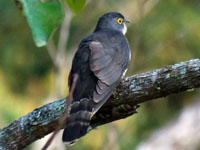
Cuckoo,_Hodgson's_Hawk- Hierococcyx nisicolor
Description: The Hodgson's hawk-cuckoo has mainly.grey upperparts with a darker mantle, crown and nape. The breast is white with chestnut streaks and the belly is white. There is a yellow eye-ring and the feet are yellow.
Range: Southeast Asia, China, eastern India, Myanmar.
Habitat: Forests, plantatiions, gardens
Diet: Insects, especially catrpillars. Also lizards and berries.
Conservation status: Least concern.
Image by: 1) Rejaul karim.rk - India 2) Peter Morris - IndonesiaRange: Southeast Asia, China, eastern India, Myanmar.
Habitat: Forests, plantatiions, gardens
Diet: Insects, especially catrpillars. Also lizards and berries.
Conservation status: Least concern.

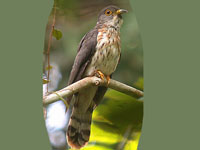
Cuckoo,_Large_Hawk- Hierococcyx sparverioides
Description: The large hawk-cuckoo is the largest of its genus. It has greyish brown upperparts with the head and nape grey. The tail is white tipped. The is a black chin-spot surrounded by white - this is unique for the hawk-cuckoos. The breast is rufous and the belly is bared black and white. There is a yellow eye-ring and the feet are also yellow.
Range: Asia, Indonesia, Malaysia, Philippines.
Habitat: Wooded areas, scrub, gardens.
Diet: Insects including caterpillars. Also eggs, berries.
Conservation status: Least concern.
Image by: 1) PJeganathan 2, 3, 4) Lip Kee - IndiaRange: Asia, Indonesia, Malaysia, Philippines.
Habitat: Wooded areas, scrub, gardens.
Diet: Insects including caterpillars. Also eggs, berries.
Conservation status: Least concern.
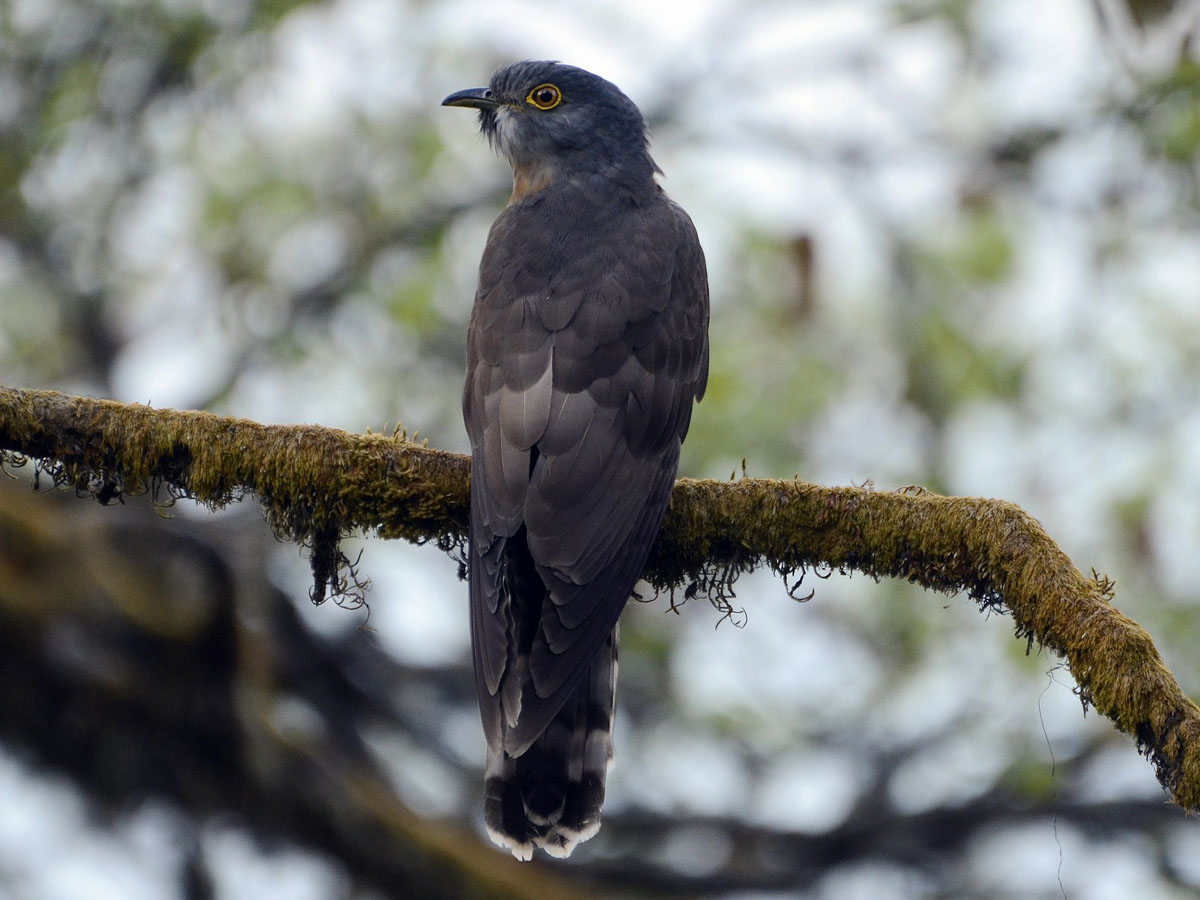



Cuckoo,_Malaysian_Hawk- Hierococcyx fugax
Description: The Malaysian hawk-cuckoo has grey upperparts with brownish wings. The chin is grey and the throat is white. It has a yellow bill with a black tip. The underparts are white with chestnut streaks on the breast. There are broad black and white bands on the tail. There is a yellow eye-ring and the feet are also yellow.
Range: Southeast Asia .
Habitat: Forests and plantations.
Diet: Insects, mainly caterpillars. Also bettles, frutis, berries.
Conservation status: Least concern.
Image by: 1) Johnny_Wee - Singapore 2) NaturellyRange: Southeast Asia .
Habitat: Forests and plantations.
Diet: Insects, mainly caterpillars. Also bettles, frutis, berries.
Conservation status: Least concern.

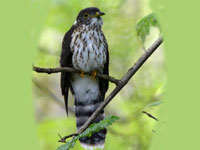
Cuckoo,_Moustached_Hawk- Hierococcyx vagans
Description:The moustached hawk-cuckoo has dark grey upperparts with some brown on the wings. The crown and nape are dark grey, the ear coverts are white, and there is a small blackish moustache. The underparts are creamy-white, with blackish streaks. There is a yellow eye-ring and the feet are also yellow.
Range: Southeast Asia.
Habitat: Forests, plantations.
Diet: Insects, fruit.
Conservation status: The moustached hawk-cuckoo is near threatened because of habitat loss.
Image by: 1) Francesco_Veronesi - ThailandRange: Southeast Asia.
Habitat: Forests, plantations.
Diet: Insects, fruit.
Conservation status: The moustached hawk-cuckoo is near threatened because of habitat loss.

Cuckoo,_Northern_Hawk- Hierococcyx hyperythrus
Description: The northern hawk-cuckoo, also known as the rufous hawk-cuckoo, has dark grey upperpars, crown, cheeks, and chin. The underparts are rufous. There is a yellow eye-ring and the feet are also yellow.
Range: Eastern China, North and South Korea, far eastern Russia, Japan, Borneo.
Habitat: Forests, plantations.
Diet: Insects, especially catrpillars. Also beetles, fruit.
Conservation status: Least concern.
Image by: 1) Lin_Sun_FongRange: Eastern China, North and South Korea, far eastern Russia, Japan, Borneo.
Habitat: Forests, plantations.
Diet: Insects, especially catrpillars. Also beetles, fruit.
Conservation status: Least concern.

Cuckoo,_Philippine Hawk- Hierococcyx pectoralis
Description: The Philippine hawk-cuckoo has dark grey upprparts. The breast and upper-belly are pale rufous and the lower-belly is white. There is a yellow eye-ring and the feet are also yellow.
Range: Philippines.
Habitat: Forests and forest edges.
Diet: Insects, especially grasshoppers. Also berries.
Conservation status: Least concern.
Image by:1, 2) Francesco_VeronesiRange: Philippines.
Habitat: Forests and forest edges.
Diet: Insects, especially grasshoppers. Also berries.
Conservation status: Least concern.


Genus Microdynamis - 1 species
Koel,_Dwarf Microdynamis parva
Description: The male dwarf koel has brown upperparts. The head is black with a white streak below the eye below which is a black malar stripe. The underparts are buffy with some rufous on the neck. The eyes are red. The female is similar with the black replaced by grey-brown.
Range: New Guinea.
Habitat: Subtropical or tropical moist lowland forests.
Diet: Fruit, especially figs.
Conservation status: Least concern.
Image by:
1, 2) Nik_BorrowRange: New Guinea.
Habitat: Subtropical or tropical moist lowland forests.
Diet: Fruit, especially figs.
Conservation status: Least concern.


Genus Pachycoccyx - 1 species
Cuckoo,_Thick-billed Pachycoccyx audeberti
Description: The thick-billed cuckoo has a very thick bill. It has dark grey to greyish-brown upperparts. The underparts and face are white. The under-tail is mainly white with a few black bars. There is a yellow eye-ring. Unlike most brood parasitic cuckoos, the large-bill cuckoo is blatant when it lays an egg in the host's nest. It will even forcefully evict the nest's owner if it necessary to deposit her egg.
Range: Africa.
Habitat: Humid or subhumid forest. Those in east Africa migrate during the dry season.
Diet: Insects, espeically caterpillars and grasshoppers.
Conservation status: Least concern.
Image by: 1) Riaan Marias - Tanzania 2) Maans_Booysen 3) Nik_Borrow - Ghana 4) Ruan_Minnaar - South AfricaRange: Africa.
Habitat: Humid or subhumid forest. Those in east Africa migrate during the dry season.
Diet: Insects, espeically caterpillars and grasshoppers.
Conservation status: Least concern.
1) Juvenile


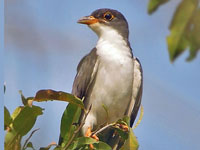

Genus Scythrops - 1 species
Cuckoo,_Channel-billed Scythrops novaehollandiae
Description: The channel-billed cuckoo has a very large bill and is the world's largest cuckoo. It has pale grey mantle, head, and most of the underparts. The under-tail has some thin black bars. The wings and upper-tail are dark grey.
It is brood parasitic and because of its size the host birds are large; for example ravens and butcherbirds.
Range: Australasia.
Habitat: Woodlands.
Diet: Fruit, especially figs. Also insects.
Conservation status: Least concern.
Image by: 1) Lance 2) Ian_Sanderson 3) Paul_Balfe 4) James_Niland - Queensland 5) Ralph Green Range: Australasia.
Habitat: Woodlands.
Diet: Fruit, especially figs. Also insects.
Conservation status: Least concern.
1) Juvenile





Genus Surniculus
The drongo-cckoos have mainly black plumage. They resemble drongos which have the same general shape and also have black plumage. Whether or not there is an advantage to this resemblance is unknown. It could be a coincidence.
Cuckoo,_Fork-tailed_Drongo- Surniculus dicruroides
Description: The fork-tailed drongo-cuckoo has glossy black plumage with a blue tinge. It has a forked tail and resembles a drongo of family Dicruridae. The bill is black and it has black orbital skin.
Range: Mainly India, also Sri Lanka and Himi\alayan foothills.
Habitat: Forests, scrub, bamboo.
Diet: Insects, especially caterpillars. Also fruit.
Conservation status: Least concern.
Image by: 1) Vijay Ismavel - India 2) Koshy_Koshy 3) Sahana_MRange: Mainly India, also Sri Lanka and Himi\alayan foothills.
Habitat: Forests, scrub, bamboo.
Diet: Insects, especially caterpillars. Also fruit.
Conservation status: Least concern.


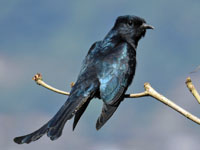
Cuckoo,_Molucccan Drongo Surniculus musschenbroeki
.Description: The Moluccan drongo-cuckoo has the general appearance of a drongo. It has black upperparts and breast plus it has a forked tail. However it has barring on the under-tail and the bill has a downward curve while a drongo's is flat.
Range: Indonesia ( Sulawesi, Buton, Obira, Bacan and Halmahera islands)
Habitat: Forests and treed savannas.
Diet: Insects; also fruit.
Conservation status: Least concern.
No public domain images available.Range: Indonesia ( Sulawesi, Buton, Obira, Bacan and Halmahera islands)
Habitat: Forests and treed savannas.
Diet: Insects; also fruit.
Conservation status: Least concern.
Cuckoo,_Philippine Drongo- Surniculus velutinus
Description: The Philippine drongo-cuckoo has mainly glossy blue-black plumage. There is a white bar on under-wing and some small white feather tips on the under-tail.The bill is slightly down-curved and the tail is slightly forked.
Range: Philippines.
Habitat: The canopy and middle storey of lowland forest.
Diet: Insects.
Conservation status: Least concern.
Image by:
1) Sergey_Yeliseev 2) Francesco_VeronesiRange: Philippines.
Habitat: The canopy and middle storey of lowland forest.
Diet: Insects.
Conservation status: Least concern.


Cuckoo,_Square-tailed Drongo- Surniculus lugubris
Description: The square-tailed drongo-cuckoo has mainly black plumage. There is a little white on the undertail. The tail is even length (sqaure) and the bill slightly down-curved.
Range: Southeast Asia, Indonesia, Malaysia, Philippines.
Habitat: Forests inluding edges and clearings, plantations.
Diet: Insects, especially caterpillars, spiders, fruit.
Conservation status: Least concern.
Image by: 1) Vijay Ismavel - India 2) Melvin_Yap 3) Eric Gropp - PalawanRange: Southeast Asia, Indonesia, Malaysia, Philippines.
Habitat: Forests inluding edges and clearings, plantations.
Diet: Insects, especially caterpillars, spiders, fruit.
Conservation status: Least concern.



Genus Urodynamis - 1 species
Koel, Long-tailed Urodynamis taitensis
Description: The long-tailed koel, also known as the Pacific long-tailed koel, has a long tail. The brown upperparts and upper-tail have wavey white bars. The white underparts have dark streaks. It has a dark eye-line and a faint white supercilium.
Range: New Zealand and other Pacific Islands.
Habitat: Forest, scrub.
Diet: Insects, eggs, small birds.
Conservation status: Least concern.
Image by:
1) John Gerrard KeulemansRange: New Zealand and other Pacific Islands.
Habitat: Forest, scrub.
Diet: Insects, eggs, small birds.
Conservation status: Least concern.
1) Adult on branch, chick on ground receiving worm from grey Warbler
